
The Battle of Trafalgar was a naval engagement that took place on 21 October 1805 between the British Royal Navy and the combined fleets of the French and Spanish Navies during the War of the Third Coalition of the Napoleonic Wars (1803–1815).

HMS Bellerophon, known to sailors as the "Billy Ruffian", was a ship of the line of the Royal Navy. A third-rate of 74 guns, she was launched in 1786. Bellerophon served during the French Revolutionary and Napoleonic Wars, mostly on blockades or convoy escort duties. She fought in three fleet actions: the Glorious First of June (1794), the Battle of the Nile (1798) and the Battle of Trafalgar (1805). While the ship was on blockade duty in 1815, Napoleon boarded Bellerophon so he could surrender to the ship's captain, ending 22 years of almost continuous war between Britain and France.

HMS Defiance was a 74-gun third rate ship of the line of the Royal Navy, built by Randall and Co., at Rotherhithe on the River Thames, and launched on 10 December 1783.

In the Battle of Cape Finisterre off Galicia, Spain, the British fleet under Admiral Robert Calder fought an indecisive naval battle against the combined Franco-Spanish fleet which was returning from the West Indies. Failing to prevent the joining of French Admiral Pierre de Villeneuve's fleet to the squadron of Ferrol and to strike the shattering blow that would have freed Great Britain from the danger of an invasion, Calder was later court-martialled and severely reprimanded for his failure and for avoiding the renewal of the engagement on 23 and 24 July. At the same time, in the aftermath Villeneuve elected not to continue on to Brest, where his fleet could have joined with other French ships to clear the English Channel for an invasion of Great Britain.
HMS Pickle was a topsail schooner of the Royal Navy. She was originally a civilian vessel named Sting, of six guns, that Lord Hugh Seymour purchased to use as a tender on the Jamaica station. Pickle was at the Battle of Trafalgar, and though she was too small to take part in the fighting, Pickle was the first ship to bring the news of Nelson's victory to Great Britain. She also participated in a notable single-ship action when she captured the French privateer Favorite in 1807. Pickle was wrecked in 1808, but without loss of life.

Bucentaure was an 86-gun ship of the line of the French Navy, and the lead ship of her class. She was the flagship of Vice-Admiral Latouche Tréville, who died on board on 18 August 1804.
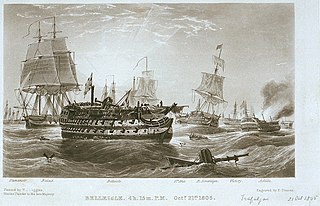
Lion was a Téméraire class 74-gun third rate ship of the line of the French Navy, which later served in the Royal Navy. She was named Lion on 23 April 1790 and built at Rochefort from August 1791 until June 1794. She was renamed Marat on 28 September 1793 and then Formidable on 25 May 1795, with the changing fortunes of the French Revolution.

Scipion was a 74-gun French ship of the line, built at Lorient to a design by Jacques Noel Sane. She was laid down as Orient in late 1798, and renamed Scipion in 1801. She was first commissioned in 1802 and joined the French Mediterranean fleet based at Toulon, in the squadron of Admiral Leissègues. Consequently, she was one of the ships afloat in that port when war with England reopened in May 1803. She participated in the Battle of Cape Finisterre and the Battle of Trafalgar. The British captured her in the subsequent Battle of Cape Ortegal. In 1810 she participated in the Java campaign, which in 1847 earned her surviving crew the Naval General Service Medal. She participated in the blockade of Toulon in 1813 and was paid off in 1814. She was broken up in 1819.

Algésiras was a Téméraire class 74-gun French ship of the line built at Lorient in 1804, named after the Battle of Algeciras.

Neptune was a Bucentaure-class 80-gun ship of the line of the French Navy. Built during the last years of the French Revolutionary Wars she was launched at the beginning of the Napoleonic Wars. Her brief career with the French included several major battles, though she spent the last 12 years of her life under the Spanish flag.
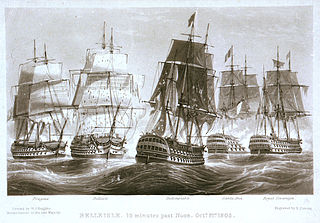
Indomptable ("Indomitable") was a Tonnant-class 80-gun ship of the line in the French Navy, laid down in 1788 and in active service from 1791. Engaged against the Royal Navy after 1794, she was damaged in the Battle of Trafalgar and wrecked near the Spanish city of Cadiz on 25/26 October 1805.

Achille was a Téméraire-class 74-gun French ship of the line built at Rochefort in 1803 after plans by Jacques-Noël Sané.

HMS Berwick was a 74-gun Elizabeth-class third rate of the Royal Navy, launched at Portsmouth Dockyard on 18 April 1775, to a design by Sir Thomas Slade. She fought the French at the Battle of Ushant (1778) and the Dutch at the Battle of Dogger Bank (1781). The French captured her in the action of 8 March 1795 during the French Revolutionary Wars and she served with them with some success then and at the start of the Napoleonic Wars until the British recaptured her at the Battle of Trafalgar. Berwick sank shortly thereafter in a storm.
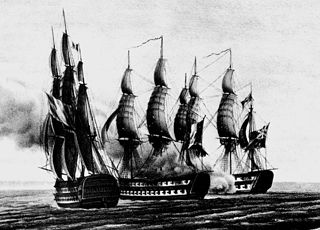
HMS Swiftsure was a 74-gun third rate ship of the line of the British Royal Navy. She spent most of her career serving with the British, except for a brief period when she was captured by the French during the Napoleonic Wars in the action of 24 June 1801. She fought in several of the most famous engagements of the French Revolutionary and Napoleonic Wars, fighting for the British at the Battle of the Nile, and the French at the Battle of Trafalgar.
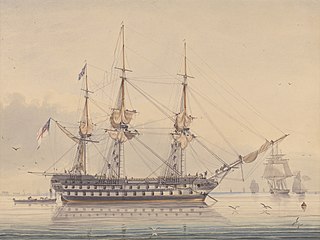
HMS Donegal was launched in 1794 as Barra, a Téméraire class 74-gun ship of the line of the French Navy. She was renamed Pégase in October 1795, and Hoche in December 1797. The British Royal Navy captured her at the Battle of Tory Island on 12 October 1798 and recommissioned her as HMS Donegal.
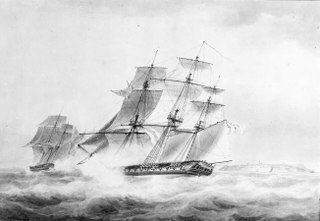
HMS Phoenix was a 36-gun Perseverance-class fifth-rate frigate of the Royal Navy. The shipbuilder George Parsons built her at Bursledon and launched her on 15 July 1783. She served in the French Revolutionary and Napoleonic Wars and was instrumental in the events leading up to the battle of Trafalgar. Phoenix was involved in several single-ship actions, the most notable occurring on 10 August 1805 when she captured the French frigate Didon, which was more heavily armed than her. She was wrecked, without loss of life, off Smyrna in 1816.

Jean-Jacques Rousseau was a Téméraire class 74-gun ship of the line of the French Navy, active during the French Directory, French Consulate and First French Empire. Renamed Marengo in 1802, she took part in Linois' operations in the Indian Ocean before her capture by the Royal Navy.

Furet, launched in 1801, was an Abeille-class brig of the French Navy. HMS Hydra captured her on 27 February 1806, off Cadiz.

Neptuno was an 80-gun Neptuno-class ship of the line of the Spanish Navy. She was built in 1795 and took part in the French Revolutionary and Napoleonic Wars. She fought with the Franco-Spanish fleet in the battle of Trafalgar, and was wrecked in its aftermath.

HMS Aigle was a 36-gun, fifth-rate frigate of the Royal Navy. Ordered on 15 September 1799 and built at Bucklers Hard shipyard, she was launched 23 September 1801. More than fifty of her crew were involved in the Easton Massacre when she visited Portland in April 1803 to press recruits. Her captain and three other officers stood trial for murder but were acquitted. Much of Aigle's career as a frigate was spent trying to keep the English Channel free of enemy warships and merchant vessels. On 22 March 1808, she was first into the action against two large French frigates, compelling one to seek the shelter of the Île de Groix batteries and forcing the other onto the shore.
















